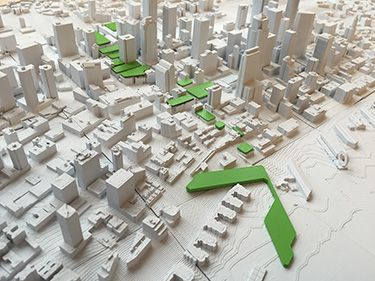|
Subscribe / Renew |
|
|
Contact Us |
|
| ► Subscribe to our Free Weekly Newsletter | |
| home | Welcome, sign in or click here to subscribe. | login |
Architecture & Engineering
| |
April 13, 2016
Forum looks at turning some empty rooftops into network of ‘sky terraces'
Journal Staff Reporter
Last year, Erica Bush of Downtown Seattle Association looked out the window of CallisonRTKL's office in a downtown Seattle high rise and gave Matthias Olt an idea.
Olt said Bush, who was at the architecture firm for a meeting, remarked on all the underused rooftops in the heart of the city.
That comment — and the need for more public open space downtown — got Olt thinking.
Olt, a design director at CallisonRTKL, thinks the rooftops of some downtown buildings would make great sky terraces for children. He envisions creating a network of 10 to 15 terraces on low- and mid-rise buildings that would run — in hopscotch fashion — from the waterfront to Freeway Park.
Staircases and elevators in plazas and at transportation nodes, such as the monorail terminus on Fifth Avenue, would get people from street level to the terraces, which could be connected by pedestrian skybridges.
| Forum Thursday |
|
Matthias Olt led a team at CallisonRTKL that created models of elevated parks. The models will be displayed at a panel discussion called “Transforming Downtown Seattle for Kids” at a forum put on by the Seattle chapter of the Council on Tall Buildings and Urban Habitat. CallisonRTKL is hosting the forum from 5 to 7:30 p.m. tomorrow at 1420 Fifth Ave., Suite 400. Go to http://tiny.cc/ncwnay to register. Besides Olt, the panelists are Craig Wrench of Washington Holdings, Gary Johnson of the city of Seattle, Lisa Picard of Skanska USA Commercial Development and Don Davies of Magnusson Klemencic Associates. The moderator is Kara Anderson of Sabey Corp. |
These elevated parks, with views of mountains, the sound and the city, would offer a perspective few children get, he said, as well as places to explore and a refuge from traffic and noise.
“If you are a child you love to climb on top of things to gain a very different view of the world, a very different sense of the place,” he said.
The elevated parks could have urban farms, p-patches, small libraries, grassy areas and skate parks, he said, along with cafes, restaurants and vendors as a way for building owners to make money.
To create each sky terrace, a modular lightweight steel frame would be assembled on the roof and attached to the building. A wood deck would be built on the frame, and a four-foot-high inward leaning enclosed glass rail would surround the deck. The terraces could be up-lit to create a striking nighttime skyline.
Olt is a native of Germany and 16-year Seattle resident who lives in Seward Park with his wife and three children. He is among a number of people who think downtown Seattle needs to offer better infrastructure and amenities for children.
“They're deprived of public open green spaces,” said Olt. “That's not only true for Seattle but for other major cities in the world.”
With land in Seattle so scarce, Olt says we need to look up. He envisions using a levy as well as public and private funds to pay for the rooftop terraces.
People in their 20s and 30s who work at Starbucks, Amazon and other companies will have kids someday, so Olt said those companies might want to contribute to making downtown more child-friendly as a way to keep workers in the city.
Olt said his firm is talking with a prominent downtown landlord about including a sky terrace for children on one of its buildings.
Olt has 22 years of architectural experience in North America, Asia and Europe. He leads the design of tall buildings and mixed-use developments.
The architect acknowledges the sky terrace proposal faces some challenges due to funding and getting skybridges approved by the city. There are also issues about liability and different uses in a building.
“This is not something that happens overnight,” he said.
But he said creating such spaces on or in buildings will become increasingly important as the city grows.
“We cannot more forward with just creating boxes in downtown,” he said. “The city in this new century needs to provide space other than a conglomeration of inaccessible box-type buildings.”
Olt's recent work includes the 65-story Lotte Center Hanoi in Vietnam and the 39-story Huarun Tower in Chengdu, China. The Hanoi project includes a public sky garden.
He also points to Commerzbank Tower, a high-rise in Frankfurt, Germany, designed by Foster + Partners that has an enclosed atrium over a retail space. Olt worked for the bank on that project.
Olympic Sculpture Park, which spans a road, is an example of creative public space here in Seattle, Olt said.
The architect said new buildings in Seattle need to be inclusive — with spaces that are open to children and the elderly — not just people who “contribute to the GDP.”
He said he hopes his sky terraces concept gets people thinking about transformative design in cities, and how to create such spaces.
Erica Bush, public realm advocate for Downtown Seattle Association, said downtown has privately owned public spaces on rooftops that include plazas and green roofs, but they were not designed with children in mind.
There are not enough public spaces that cater to families and children, she said, but the sky terraces could create a network of such spaces.
Bush has not seen Olt's final plan, but she said the possibilities for family-oriented activities on some Seattle rooftops are endless. “It's just a huge amount of square footage that we don't take advantage of.”
Lynn Porter can be
reached by email or by phone
at (206) 622-8272.



